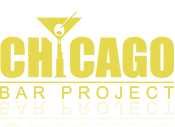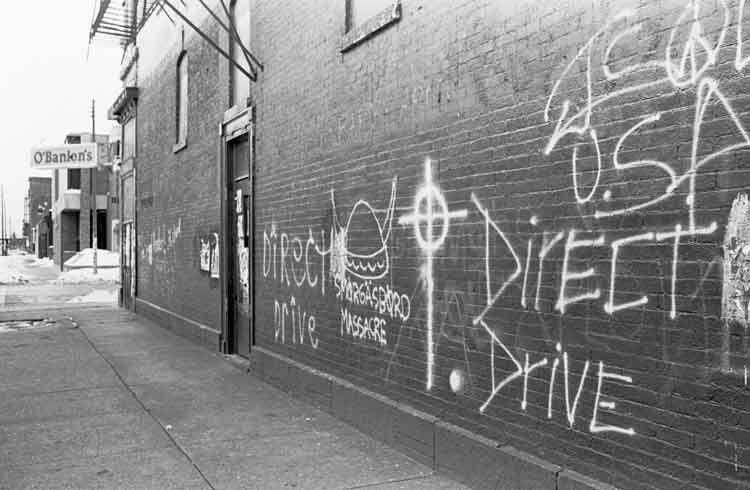Editor’s Note: sadly, this writer was too young to have visited O’Banion’s in its heyday, so most of what follows is taken from two Chicagoans that were integral parts of the defunct Chicago punk scene of 1978-83. The first is Ken Mierzwa, photographer and author of Ephemeral Creation – a personal memoir of his Chicago punk experience with some additional photos. The second is Frank Eck, drummer for the Chicago New Wave band The Dadaistics and who regularly performed at O’Banion’s from 1978-80. O’Banion’s is now the Irish pub, The Kerryman.
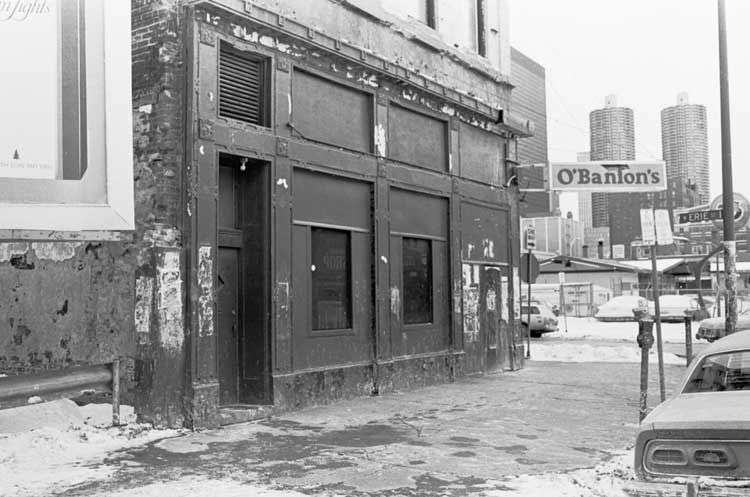
Photo by Ken Mierzwa
© Copyright 2003
Following the demise of Chicago’s first punk club, Le Mer Viper when it burned down in 1977, a new bar by the name of O’Banion’s opened up at the northeast corner of Clark & Erie in River North and quickly became a Chicago legend. O’Banion’s was not exactly “aesthetically pleasing” or even “clean,” but it did play host to a litany of local talent and national acts like the Dead Kennedys, Husker Du and The Replacements. This was a far cry from its previous incarnations as a gay bar, the largest strip club in Chicago at one point and a “Bugs” Moran hangout. As punk rock yielded to new wave, so did the neighborhood to gentrification and O’Banion’s was sold and turned into an upscale restaurant. Though it only existed for four years, it’s influence on Chicago music can be felt today in such venues as Metro, Empty Bottle, Neo and Exit.
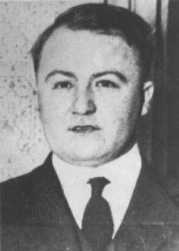 O’Banion’s was in fact named after Dion O’Banion, a Chicago gangland figure that operated a flower shop in the 1920s, originally located nearby. O’Banion was an associate of Bugs Moran, Al Capone’s arch-rival, and is described by historian Frederick Lewis Allen as, “…a bootlegger and gangster by night, a florist by day; a strange and complex character, a connoisseur of orchids and of manslaughter.” Because of this, as well as having thoroughly pissed of the Sicilian Genna Brothers, O’Banion was murdered by Capone’s henchmen in his shop. Three men walked in and, when Dion went to shake the middle one’s hand, the other two fired two bullets into his chest, two in his throat, and another blew his jaw away while the third man (Frankie Yale) still gripped his hand so that Dion could not reach for his guns in time (which he usually kept on him in concealed fashion). Rumor has it that it was Dion’s clean-cut Irish persona was used in Hollywood to portray gangsters, including those played by James Cagney.
O’Banion’s was in fact named after Dion O’Banion, a Chicago gangland figure that operated a flower shop in the 1920s, originally located nearby. O’Banion was an associate of Bugs Moran, Al Capone’s arch-rival, and is described by historian Frederick Lewis Allen as, “…a bootlegger and gangster by night, a florist by day; a strange and complex character, a connoisseur of orchids and of manslaughter.” Because of this, as well as having thoroughly pissed of the Sicilian Genna Brothers, O’Banion was murdered by Capone’s henchmen in his shop. Three men walked in and, when Dion went to shake the middle one’s hand, the other two fired two bullets into his chest, two in his throat, and another blew his jaw away while the third man (Frankie Yale) still gripped his hand so that Dion could not reach for his guns in time (which he usually kept on him in concealed fashion). Rumor has it that it was Dion’s clean-cut Irish persona was used in Hollywood to portray gangsters, including those played by James Cagney.
The building housing O’Banion’s was once the McGovern Saloon, which was frequented by Dion’s former ally, Bugs Moran. The saloon then become Chicago’s largest strip club in the 1950’s, known as the Liberty Inn. Following that, the space was turned into more than one gay bar – one for the ladies and one for men called PQ’s. The latter was the predecessor to O’Banion’s and it is said that the “rougher” male crowd, who had a penchant for leather, would continue to go to the club thinking that it was still a gay bar. This apparently added to the edgy atmosphere once the punk rockers began to descend on O’Banion’s.
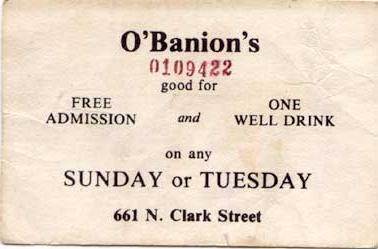 O’Banion’s opened for business in 1978 and was owned by the same guy who owned one of the fine area liquor stores. According to Ken Mierzwa, what is now the rather posh River North area, was something different back then: “…it was still a pretty marginal area, with graffiti on the walls and sleazy liquor stores, the kind where patrons put their money, or sometimes a watch or a diamond ring, through a semi-circular opening in the bullet-proof glass and get a pint bottle back in exchange. The section of Ontario Street immediately to the south was, literally, skid row at that time with numerous bums in cardboard boxes.” The painted brick walls of O’Banion’s were covered with some of the same graffiti and a small O’Banion’s sign was the facade’s only adornment. Through a flimsy wooden door with a tiny diamond window you’d find an interior featuring a long narrow space with a worn wooden bar running most of its length. Elsewhere in the front room was a bench against the wall and a pinball machine in the corner. Bands played in the rear, which was larger than the front and featured a small raised stage at the back. Some seating could be found beneath the narrow balcony that ran along both sides of the room. There was also a DJ booth in the southeast corner, a smallish space accessible only by ladder. In the background was an unnerving crashing sound that could be heard when the band wasn’t going full tilt. Mierzwa describes the din as stemming from, “…empty bottles of Stroh’s tossed into the big plastic garbage can at the far end of the bar. It was standard background noise at O’Banion’s, soon just an accepted part of the atmosphere…” O’Banion’s was a late-night bar, and the Stroh’s could be heard shattering nightly until 4am and 5am on Saturdays.
O’Banion’s opened for business in 1978 and was owned by the same guy who owned one of the fine area liquor stores. According to Ken Mierzwa, what is now the rather posh River North area, was something different back then: “…it was still a pretty marginal area, with graffiti on the walls and sleazy liquor stores, the kind where patrons put their money, or sometimes a watch or a diamond ring, through a semi-circular opening in the bullet-proof glass and get a pint bottle back in exchange. The section of Ontario Street immediately to the south was, literally, skid row at that time with numerous bums in cardboard boxes.” The painted brick walls of O’Banion’s were covered with some of the same graffiti and a small O’Banion’s sign was the facade’s only adornment. Through a flimsy wooden door with a tiny diamond window you’d find an interior featuring a long narrow space with a worn wooden bar running most of its length. Elsewhere in the front room was a bench against the wall and a pinball machine in the corner. Bands played in the rear, which was larger than the front and featured a small raised stage at the back. Some seating could be found beneath the narrow balcony that ran along both sides of the room. There was also a DJ booth in the southeast corner, a smallish space accessible only by ladder. In the background was an unnerving crashing sound that could be heard when the band wasn’t going full tilt. Mierzwa describes the din as stemming from, “…empty bottles of Stroh’s tossed into the big plastic garbage can at the far end of the bar. It was standard background noise at O’Banion’s, soon just an accepted part of the atmosphere…” O’Banion’s was a late-night bar, and the Stroh’s could be heard shattering nightly until 4am and 5am on Saturdays.
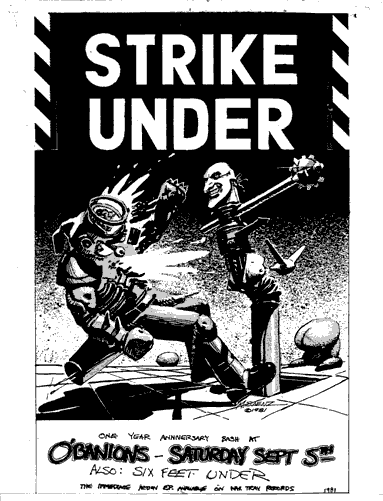
Flier courtesy of Marie Kanger-Born
Some of the local bands that played at O’Banion’s included: Naked Raygun, Poison Squirrel, Trouts, Strike Under, The Dadaistics, Direct Drive/Articles of Faith, Fix, Phil n’ the Blanks, Subverts, Skafish, Tense Experts, and Immune System. The scene at O’Banion’s also attracted national touring talent like the Dead Kennedys, Husker Du, T.S.O.L., and The Replacements, as well as some of the original British punk bands. After Le Mer Viper succumbed to a mysterious fire ironically in the Year of the Snake, O’Banion’s was the place to go for punk rock. It became so popular and well known, that a bevy of other punk rock joints opened up, also in sketchy and/or industrial parts of the city, including Neo, Metro, Artful Dodger, Lucky Number (which later became Club 950 Lucky Number), Lounge Ax, Oz, Gaspar’s, West End Club, Tut’s, Waves, Stages, Head’s Pub, and Misfits. Just because it was feverous doesn’t mean that O’Banion’s offered any kind of amenities for performers. According to Frank Eck, “O’Banion’s was, bar none, the worst place to play at. There was no stage, no PA system (bands brought their own and played on the floor), no dressing room, virtually no lighting and no one in charge of the place. Worse still, both its restrooms rarely, if ever, functioned (once someone actually crapped on the floor next to my drum kit). However, in spite of all that, I have very fond memories of the place, having played some very fun gigs there.” Near the end, a tiny makeshift stage was added and the give and take of musician interviews and photographs took place downstairs in a tiny room with graffiti on the walls and lit by a 60-watt bulb.
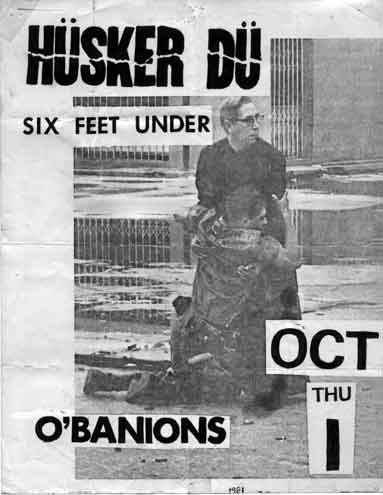 Flier courtesy of
Flier courtesy of
Marie Kanger-Born
Photos by Ken Mierzwa
© Copyright 2003
Photos by Ken Mierzwa
© Copyright 2003
“I’m the one in the middle of the three, smoking the cig… I’m Nancy and I put O’Banion’s together after La Mere burnt down. I went to Russell, the owner and started talking to him about making his bar a success, which it wasn’t at the time. He said ‘Show me,’ so I started taking him to shows. He loved the scene and the energy and the insanity and said that he wanted to start having punk weekends. At the time I was the DJ at Marilyn’s, a lesbian bar, and at Sunday’s, a gay men’s bar down the street, on Clark… I worked on weekends and missed the first weekends. Damn. The DJs included Sparkle, Little Dougie, Mark Moon, I think and probably Rick Radio. I began bringing Jimmy and Cleary down to Marilyn’s where they would get up and dance to Xray Spex, which basically terrified everyone. It was a blast. Eventually Jimmy and Cleary were too wasted and got into some fights… Alan, the owner of Sunday’s/Marilyn’s barred Jimmy and Cleary off the street. Can you do that??? I was tired of playing at Marilyn’s so I got fired. Yeah!!! Finally I got to go to the weekends at O’B’s. One day Russell decided to go all punk so I probably worked all five days along with my old buddy Michael Bakunis. Michael used to work at Sunday’s. Eventually, as things shifted around, Michael and I were the DJs with a little help from Jack Rubenstein and this guy named Michael… After a while, with no knowledge of the subject, I started booking the bands…. I remember them bringing Adrian Bellew of BIG ELECTRIC CAT fame. He used to play with a lot of artists like Zappa. What a great show… Since I hung out with the Dead Kennedys, (Darren is still my friend to this day), I got them to play. Jello made me promise to have a shitload of bands on the bill which I had no problem doing. It was insane! I don’t think we had a stage yet. Who cared. I have a couple pictures. In one you can see Al Jourgensen of the evil Ministry, complete in New Romantic hair just mesmerized. TSOL played too, another time.”
– N.R. (December 10, 2003)
Regarding the horde of rockers that called O’Banion’s home, sometimes almost literally, Ken Mierzwa sums it up in this way:
“The ‘punk’ scene had not yet become a fashion show, and in those early days there was a real mix of clothing styles. I remember lots of jeans and a few flannel shirts and plain tee shirts, some ratty salvation army chic, maybe a few leather jackets but not like it would be a year later. No one person really stood out from the crowd. But what did strike me was that no one was passing judgment on anyone else. Here we were, college kids just down from the suburbs, and while no one really went out of their way to be friendly, no one stared or acted rudely either. Considering how drunk some of those people were, that was actually a little surprising. I was accustomed to bars where fights were routine and lots of people acted like assholes after a few too many beers. While a few of these folks looked a little scary, like they hadn’t had any sleep in days, it was basically live and let live. Quite a while later, in my journal, I commented on my early impressions of O’Banion’s:
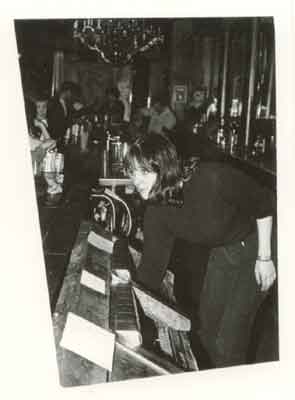
Photo by Ken Mierzwa
© Copyright 2003
‘December 19, 1980: I have yet to convince myself that I know what made all the people in those bars what they are. They certainly have things in common, but there is also much diversity; in background, in education, upbringing, income, neighborhood, previous musical taste, and who knows what else. What drew them to this place? Individualism, certainly. Escapism, often. They attract attention, but many only reluctantly, and usually only at night. Many dress very ordinarily during the day, hold traditional jobs. It’s a relatively small group, and proud of it. While outsiders are not discouraged, they tend to feel uncomfortable until they learn the music and the dress. What role does violence play? It’s always there, felt, just below the surface, but very rarely openly expressed. Perhaps the music and dancing is the release, the safety valve, that prevents open, physical violence.’“
In the early 1980’s, punk was giving way to new wave, and O’Banion’s followed suit in part by hosting local bands like Bohemia but was still widely regarded as the “purest” punk scene even with all its competitors. A few years later, new wave would give way to synthesized pop and video clubs became the rage as the world was plunged into a musical Dark Age that lasted until Nirvana unleashed Nevermind in 1991. As such, O’Banion’s was struggling to stay in business after four years. At least one benefit concert was held but it only prolonged the inevitable. On a cold day in February 1982, O’Banion’s shuttered its doors. This was the beginning of the end for Chicago punk as the scene would almost entirely disappear only one year later, even after droves of suburbanites started to pick up on the music. However, as Marie Kanger-Born points out, “The scene did continue, but split into two different scenes– there was the (watered-down) bar-based punk scene in places like Exit, Dreamerz and G-Spot. However, the real scene continued on under the title of ‘hardcore.’ This new scene revolved around the support of bands, rather than the support of particular bars. It was an under-age scene.” The O’Banion’s space has since hosted numerous shi-shi restaurants and poorly thought-out bars, as the River North area gentrified around it. While O’Banion’s and the memorable staff of Nancy, Roseann and Phil are just a memory, many places still exist that host alternative bands that play in a spirit similar to the punks: Mutiny, Metro, Empty Bottle, Double Door, Fireside Bowl, and Hideout – just to name a few. The now-defunct Prodigal Son once had Bob Mould of Husker Du play and both Neo and Exit also provide a shelter for nuevo punks. In addition, Club Foot hosts an O’Banion’s reunion every summer that is organized by former O’Banion staffer Roseann who now bartends there – they even fly in Nancy for the occasion. For one that can appreciate what music in Chicago is today, I have to say hats off to O’Banion’s for helping us get there.
“I remember dancing there with my friend Roslyn, and seeing the same excitement in her eyes that I must have had the first night. That was one of the best parts, seeing the excitement on the faces of first-timers.”
– excerpt from Ephemeral Creation by Ken Mierzwa
“Regarding the genesis of O’Banion’s, I was with Taco and Sparkle along with Steve Smith in June of 1978 when the four of us piled in a cab outside of Cheeks and Sparkle said, “You guys come with us. I want to check out this bar to see if we can turn it around with good music.” It was O’Banion’s. And when we walked in, Taco, Sparkle and Steve went to the back for a meeting about turning this old beat up drag bar into a haven for new music. There was one lone old drag queen, who looked like Rod Steiger in a wig, nursing a cocktail at the bar. I must’ve looked kind of lost when this trucker in drag said, “Come on, SMILE honey, Nothing is THAT bad!” Taco an Sparkle from La Mer Viper deserve the credit for creating O’Banion’s.
And at the beginning, it was inner city kids who frequented this bar, not the suburban kids. That came later. In the beginning it was displaced kids who couldn’t relate to disco or the Rush Street scene or the old hippy bars or the sports bars. We played Iggy Pop, Ultravox, The Clash, Sex Pistols, Blondie, Buzzcocks, The Jam… and whoever wrote in your article that no one stood out, could not have been there at the beginning. There were many people who stood out and not in a fashion way but in a completely individual way… These names were iconic in those days… Natasha, Mod Todd, Frankie, Hope, Noah, Russell, Punkie, Lori Eastside, Judy Teen, Nancy, Terry Fox, Butchie, Max, Christian, None, Jill, Danny Hursch, Steve Smith, and me. About nine months after it opened, we were invaded by weekend punks, suburban kids, and Rush Street lookie-loos. Of course, that meant more money for the till but the magic of the first nine months cannot be overstated. It wasn’t just a bar but a moment in time and a way of life.”
– L.W. (August 3, 2010)
An O’Banion’s story from T.B., now living in Grosse Pointe, Michigan:
Dear Sean:
A friend of mine and I graduated from the University of Michigan in 1975. He, some friends we had also gone to school with elsewhere in Michigan, and some other assorted acquaintances, all moved to Chicago after graduation. In 1976, I was living in Detroit. I developed the habit of visiting Chicago on occasional weekends because there was more than one place to crash, and expenses were relatively reasonable.
We typically invaded Le Mer Viper during these visits but on a visit sometime in the late 1970’s, I can’t remember the precise year, we migrated to O’Banion’s because of the fire. Just as you recounted in your essay, we arrived in the early evening when the place converted from gay bar to punk club.
This was my only visit ever to O’Banion’s and many of the details today are very foggy due to my extreme, ultra-inebriation at the time. I do remember getting so drunk that I split up from my party and asked a total stranger to dance, who agreed. After that, I was somehow able to ask her if she wanted to step outside, ostensibly to hold a conversation which was impossible to conduct otherwise in the raucous din prevailing inside the bar.
Once outside, we both sat on the curb and I learned she was a dancer who hoped to dance professionally, which I took to mean as a ballerina or something. I performed in what I conceived to be at the time the role of a coherent interlocutor until, suddenly overcome by a tidal wave of dizziness and nausea, I excused myself and went to throw up on the nearby brick wall of the bar. This made an understandably negative impression on my new acquaintance, who told me she had an appointment and left, leaving me on the curb where I struggled to restore my equilibrium.
Unfortunately, the party I had arrived with saw me leave the bar with this woman and, assuming I was making alternative plans, left O’Banion’s for home without me. Shortly after 2 a.m., some kindly patrons leaving the place tried to rouse me from the curb where I had passed out, in the gutter, essentially, to advise me that I would probably get rolled if I remained there in that condition.
I appreciated the wisdom of this advice and somehow, realizing that I had been abandoned at the venue, managed to summon a taxi driver who got me back to the apartment of one of my compeers by driving down streets whose names I remembered from the trip to O’Banion’s, and taking left or right turns at corners that looked vaguely familiar to me. I couldn’t call it exactly a typical trip to O’Banion’s since it was the only time I made it there, but I guess you could call it the summation of my experience. Thanks for your really wonderful reminiscence. (November 22, 2005)
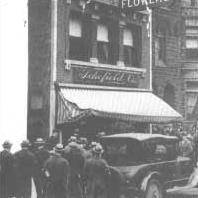
Dion O’Banion’s flower shop
